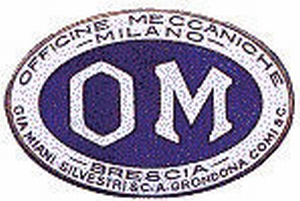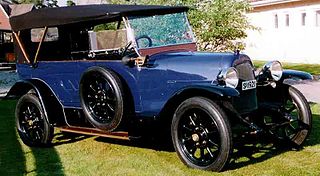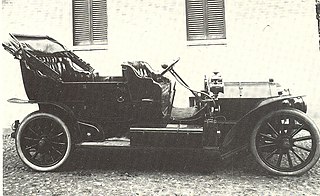
The Fiat 128 is a transverse front-engine, front wheel drive small family car manufactured and marketed by Fiat from 1969 to 1985 as a two- or four-door sedan, three- or five-door station wagon as well as two- or three-door coupé. The 128 running gear and engine, reconfigured for a mid-engined layout, were used in the Fiat X1/9 sports car.

Officine Meccaniche or OM was an Italian car and truck manufacturing company. It was founded in 1899 in Milan as Società Anonima Officine Meccaniche to manufacture railway rolling stock and car production began in 1918. It disappeared as such in 1975, subsumed into Iveco, but still exists as a forklift builder.

Delage is a French luxury automobile and racecar company founded in 1905 by Louis Delâge in Levallois-Perret near Paris; it was acquired by Delahaye in 1935 and ceased operation in 1953.

The Fiat 600 is a small, rear-engined city car and economy family car made by Italian carmaker Fiat from 1955 to 1969 — offered in two-door fastback sedan and four-door Multipla mini MPV body styles. The 600 is considered a pop icon of the Italian economic miracle, and the three-row seating Multipla, though diminutive and odd-looking, is seen as one the first mass-produced minivans.

The Auto Avio Costruzioni 815 was the first car to be fully designed and built by Enzo Ferrari. Legal issues with former associates Alfa Romeo prevented Ferrari from creating the Ferrari marque. The 815 raced at the 1940 Brescia Grand Prix, where both entries failed to finish due to engine problems. One of the cars was later scrapped, while the other is currently in a car collection in Italy.

The Fiat 124 Sport Coupé is a two-door, four-seater notchback coupé produced by the Italian automaker Fiat in three generations between 1967 and 1975. It was based on the Fiat 124 saloon.

The Fiat 4 HP was the first model of car produced by FIAT, from 1899 to 1900 based on a third party design.

The Fiat 850 is a small rear-engine, rear-wheel-drive car manufactured and marketed by Italian car manufacturer Fiat from 1964 to 1973.

The Fiat 1400 and Fiat 1900 are passenger cars produced by Italian automotive manufacturer Fiat from 1950 to 1958 and from 1952 to 1959 respectively. The two models shared body and platform, but while the 1.4-litre 1400 was Fiat's intermediate offering, the upmarket 1900 had an enlarged 1.9-litre engine and more luxurious trim and equipment, to serve as flagship in the manufacturer's range.

The Fiat 518, also called Fiat Ardita, was a model of car produced by Italian car manufacturer Fiat between 1933 and 1938. The name "Ardita" was also used on the six-cylinder engined and more expensive Fiat Ardita 2500 or 527.

The Macchi M.39 was a racing seaplane designed and built by the Italian aircraft manufacturer Aeronautica Macchi. The type is most remembered for its settings of multiple world speed records during the mid 1920s, as well as for winning the Schneider Trophy, for which the M.39 had been specifically developed.

The Fiat 10 HP was the fifth model of the Italian car manufacturer Fiat, produced in 1901. Together with the Fiat 8 HP, it replaced the Fiat 6 HP, being an evolution of this model. The Fiat 6 HP had in turn been based on the Fiat 3.5 HP designed for FIAT by engineer Aristide Faccioli. Both the 6 HP and the 10 HP were also designed by Faccioli. The technology remained the same. However, the seating layout was changed: while the 6 HP offered vis-à-vis seating, the 10 HP was a Phaeton with two rows of seats.

The Peugeot 601 was a range-topping car produced between 1934 and 1935 by Peugeot. It had its formal launch on 5 May 1934 and marked a return by the manufacturer to six-cylinder engines.

The Fiat 1800 and 2100 are six-cylinder automobiles produced by Italian manufacturer Fiat between 1959 and 1968. Both models were introduced in 1959. A four-cylinder 1500-cc version, the 1500L, was added to the range in 1963, when the 2100 was replaced by the larger engined 2300. The 1800/2100 were designed by Fiat's own Dante Giacosa.

The Fiat 505 is a passenger car produced by Fiat between 1919 and 1925. The 505 was based on the same basic design as the four cylinder Fiat 501, but with a larger engine and bigger exterior dimensions. With a 2296 cc (30 hp) engine, the car could reach a top speed of 80 kilometres per hour (50 mph).

The Fiat 8 hp is a car produced by the Italian manufacturer Fiat in 1901. The car has a straight-2 engine rated at 8 hp and a top speed of 45 kilometres per hour (28 mph).

The Fiat 24-32 HP was introduced by the Italian automobile manufacturer Fiat in 1901. The car was designed to allow coachbuilders to make various bodies to fit. It was offered with three different wheelbases, short, medium and long.
Halberstädter Flugzeugwerke or Halberstadt was a German aircraft manufacturer. It was formed on 9 April 1912 under the name Deutsche Bristol Werke Flugzeug-Gesellschaft mbH in Halberstadt, Province of Saxony.

The Maserati Ghibli is an executive car produced by Italian automobile manufacturer Maserati. The car was unveiled to the public at the 2013 Shanghai Motor Show. The Ghibli ended production at the end of 2023.
Alfa Romeo A15 / A19 / A38 / F20 are a discontinued line of utility trucks, or lorries, produced by Alfa Romeo from 1967 to 1974.





















